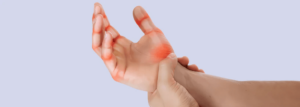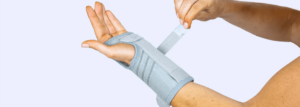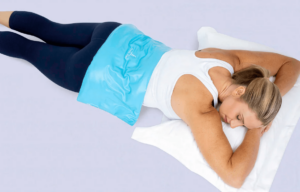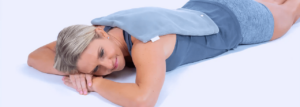Best Ways to Treat a Sprained Thumb
Home Remedies Physical Therapy Surgery Prevention Safety
Choosing the best sprained thumb treatment method isn’t always straightforward. It is important to find the right treatment option quickly before the pain and instability leads to more severe tears. We’ve created this article to guide you in treating your sprained thumb to get you back to all the activities you enjoy.
Home Remedies
Home treatment can be a safe and effective way to manage sprained thumb symptoms at home. See some simple remedies you can try today.
Using the RICE Method
A mild thumb sprain can be treated at home with the RICE method. Check out below for the specifics on this treatment option.
- Rest
- Thumb injuries like sprains respond well to rest. The ulnar collateral ligament (UCL), which is the ligament typically involved in a sprained thumb, needs plenty of time to heal. Resting your thumb will give your body a chance to repair the damage. Be sure to avoid activities that involve using your thumb and protect it with a splint or brace.
- Ice
- After a sprain, it’s important to ice your thumb and thumb joint. The cold helps to reduce swelling, bruising, and pain. Use an ice pack or submerge your thumb in a cold bath. Ice the injury for 15-minute intervals for 24 to 48 hours. Avoid sleeping with an ice pack, if the cold is left on your skin for too long it can cause a skin injury.
- Compression
- Use compression with a bandage or thumb spica brace for 24 to 48 hours. A bandage is better for the compression, but a spica cast or brace will immobilize your thumb to help prevent further damage. Both options will reduce swelling within the soft tissue of the thumb, in turn, this reduces pain and helps to improve healing time.
- Elevation
- Raising your thumb above the level of your heart will reduce swelling by encouraging fluid to return to the heart and not pool in the area around the thumb. Prop your hand and thumb on a couple of pillows. Keep your thumb elevated intermittently for the first two days after your injury.
Pain Medication
One way to treat the pain associated with a sprained thumb is to take over-the-counter pain medications. NSAIDs like ibuprofen and naproxen are two common drugs that are inexpensive and widely available. Acetaminophen (Tylenol) is another medication that can help provide some pain relief. Always talk to your doctor or pharmacist before you take a new medication to avoid any unintended side effects.
Stretches and Exercise
After the initial injury phase has passed you can start stretching and exercise your arm, hand, and thumb. Stretching will help you maintain or regain the range of motion in your thumb. Exercise will strengthen the surrounding muscles to help prevent an additional injury. You should start slowly and build up endurance slowly over time.
Check out this article to learn more about sprained thumb exercises.
Taping
Taping a sprained thumb will help reduce its range of motion and provide a small amount of compression to the injury. The compression will reduce swelling, whereas reducing the range of motion will let the thumb ligament heal and avoid further injury. Athletic tape is inexpensive and can be adjusted to fit your specific circumstances and injury.
To learn more about taping your sprained thumb read this article
Physical Therapy for Thumb Injuries
For more severe sprains your doctor may recommend seeking treatment from a physical therapist. Your physical therapist will evaluate your injury and work out a treatment plan for you. During your sessions, you might be guided through stretching, exercises, or be shown how to modify your movements to prevent reinjury. Frequently, physical therapists will send you home with handouts and tools to continue your rehab while you’re not in the office with them.
Thumb Surgery
Surgical treatment is necessary when the thumb has lost its stability or if you have a torn ligament. Orthopaedic surgeons will look at your injury and may recommend an x-ray or other imaging to determine the extent of the ligament injuries. There are multiple types of surgical procedures that can be done which are covered below.
Suture Repair
During a suture repair surgery, the surgeon will make a small incision on the thumb, at the back of the MCP joint. Then the surgeon repairs the ligaments with sutures (stitches) and secures the ligaments to the bone. The best outcomes from a suture repair are when the surgery is done within four weeks of the injury.
Fusion
Unstable joints from a thumb sprain are more prone to developing arthritis. As a result, some surgeons will reconstruct injured ligaments by grafting in new tissue. This is a fusion procedure and is the surgery of choice for patients who work in jobs that put significant strain on their thumb. The downside to a fusion surgery is that it prevents the thumb from moving.
Post-Surgical Treatment
Follow-up with the surgeon and a physical therapist is incredibly important after thumb surgery. Your surgeon will evaluate the incision site and determine if any additional treatment is necessary. A physical therapist will help you work through the stiffness after surgery and encourage you to strengthen the muscles surrounding the site. Follow any recommendations by your surgeon regarding rest, splinting, and pain management.
Preventing an Injury
You’ll never be able to eliminate all activities that cause a sprained thumb. Skiing is one activity that is more commonly associated with sprains. The ski pole gets caught up in the thumb and hand during falls and can cause a sprained thumb. If you ski practice falling with your ski poles to be best prepared for the situation. Here are a few other ways to prevent thumb sprains:
- Strengthen surrounding muscles
- Stretch your hand and thumb
- Avoid activities that extend the thumb
Safe and Effective Sprained Thumb Treatment
Safe and effective treatment of a sprained thumb starts with RICE and splinting. These home treatments are simple and inexpensive. If that isn’t enough then physical therapy or surgery may be necessary. Always talk to your doctor if you have injured your thumb to help you determine the best treatment plan for your situation.







